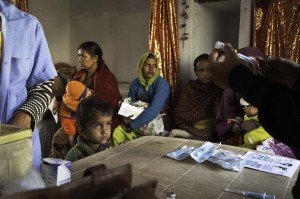Facilitating Immunization

Low levels of child immunization
Immunization is one of the most effective means of reducing preventable illness, yet multitudes of Indians remain unprotected. In slum areas like Janta Colony, several factors are evident: lack of awareness, distrust of “modern” medicine and poor access to medical facilities. For many families, the cost of hiring a rickshaw to travel the 5 km to Chandigarh is simply out of reach.
Actions taken
Initial efforts by HPs to convince parents to immunize infants and young children produced poor results, for all of the reasons described above. DIR then intervened by offering the assistance of HPs if Health Department officials would begin holding immunization clinics in the basti. The HPs coordinate the flow of traffic on clinic days, distribute medication and record immunizations received on each child’s health chart. In the days leading up to clinics, HPs visit the parents of children due for first or booster shots. When mothers are working or busy, HPs sometimes bring the children themselves.

Almost 100% of children in Janta Colony are fully immunised, compared to national averages of 40% to 60% (depending on disease).
Results
For the past several years, immunization clinics have been held in the basti every Wednesday. At one point, HPs celebrated the achievement of 100% coverage: every person in the slum (including lactating women) had received all the recommended shots. A subsequent drop reflected the transient nature of slum life: 250 new residents arrived after being displaced from an illegal slum that the government bulldozed. With continued effort, many of these individuals have also been inoculated and the rate in Janta Colongy stands at 90% coverage.
